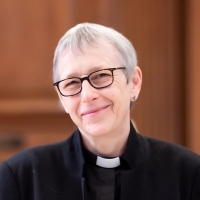My late father-in-law (God rest his soul) was a dear man, who was incredibly proud of his Irish ancestry (the Joyces are from Co. Mayo) – and as part of that heritage, he was also a very devout in his Christian faith. Amongst other things he was a very committed member of the Vincent de Paul Society at his local church, and well into his eighties he would regularly go out on pastoral visits to those whom he described as the ‘poor old boys’ in his congregation – completely oblivious of the fact that he was considerably older than many of the ‘old folk’ he was visiting.
And when my daughters were very young, he would occasionally give them little children’s booklets that he picked up from his church, each of which recounted the life of a famous saint.
To be honest, those little tracts were a bit ghastly – although certainly no worse than the kind of thing that I received from my own church when I was young. And regardless of the specific saint in question, the essential story always seemed to be the same – and one suspected had a bit of a subtext, which was to persuade children that basically God just wanted them to be very well behaved.
These saintly stories generally went as follows. Each saint as a child was dutiful, kind and patient, and utterly selfless; he or she never lost their temper; they always went out of their way to help other people, and they spent all his time praying. When they grew up, he gave up all worldly things and lived a life of exemplary goodness, piety and wisdom, dedicating his life to the service of the poor. People flocked to see them, and when they touched those who were sick their illnesses went away. When he died people reported further miracles, so Radbod was canonised as a saint.
All highly commendable, and very other-worldly, I’m sure – but as a model for Christian sainthood, it is actually slightly problematic. The saints of the Bible were not like that at all – certainly not squeaky clean, pious, compliant and good.
We have St Peter, who is the most flawed of human beings: a man who always acts before he thinks, who has boundless enthusiasm but little understanding, and whose courage and loyalty to Jesus fail utterly and terribly at the very moment that they are put to the test. Or St Paul who, as the Pharisee Saul was the most savage persecutor of Christians. The first followers of Jesus were ordinary working men and women, some of them outcasts; many of them vulnerable, weak, lost and broken – and all of them with the deep and all-too recognisable failings that we all share as human beings.
I would not disagree for a moment that saints are exceptional people who stand out from the crowd – but that is not because they lack our normal human flaws and frailties – far from it. Many of you will have heard me quote a remarkable but profoundly true saying by Oscar Wilde (of all people) – who wrote: ‘How else but through a broken heart can Lord Christ enter in?’ How very true. Because unless we recognise our own brokenness, we cannot recognise our need of God’s forgiveness and grace.
So, what is it that truly characterises a saint? There is an old saying that saints are like stained glass windows – because the light of God shines through them bringing illumination and colour into the lives of those around them. But if you think about it every window has the power to communicate light– even those that are broken. Indeed, the simpler and more transparent the window, the more the light will be able to shine through.
In my own experience, there is in fact a two-way process here, just as you can see through both sides of a window. Because those whose lives communicate the light of Christ most effectively simply through being who they are – are often those who are also most attuned to the pain of the world: it is as if they see things, and feel things, with unusual clarity, as well as being bearers of light.
There is a remarkable novel by Sue Monk Kidd, first published in 2001, called The Secret Life of Bees. At the heart of the story are three sisters who keep bees, one of whom is a strange, vulnerable woman called May, who is obsessive about things in ways that can drive those around her mad. But the most striking and disarming thing about May is that she feels the pain of the world so intensely that she is completely disabled by it. As one of her sisters explains (and I quote):
When you and I hear about some misery out there, it might make us feel bad for a while, but it doesn’t wreck our whole world. It’s like we have a built-in protection around our hearts that keeps the pain from overwhelming us. But May – she doesn’t have that. Everything just comes into her – all the suffering out there – and she feels as if it’s happening to her. She can’t tell the difference.
In May’s case, her transparency and connectedness with the suffering of the world is so acute that it is completely disabling. But in a strange way, I can’t help feeling that somewhere within all of that there is also something of the true essence of sainthood. After all, the word ‘compassion’ means literally ‘suffering with’: when you are compassionate, you are feeling the pain of another and responding to it. Therefore, it goes without saying that a compassionate heart cannot avoid being profoundly affected by the suffering of our world, and of the people around us.
Certainly those people whom I have known during the course of my ministry whom I would count amongst God’s saints, were emphatically not those who lived exemplary lives of moral rectitude; or whose faith was rock solid; or who were strong and capable and in control of life. On the contrary – most of them were pretty broken and vulnerable, and unusually aware of their own failings. But they were also without question people of compassion; people who saw the pain and suffering in the eyes of those around them, and who felt that pain viscerally.
And, in the process, they opened my eyes to all of that hurt, and jolted me into recognising that I, too, should be responding. And they would have laughed themselves silly and told me not to be ridiculous, if they knew that I was including them in a discussion about the true nature of saintliness.
The poet and artist William Blake was a man of profound, if unorthodox religious faith. As he put it: ‘Where others see but the dawn coming over the hill, I see the soul of God shouting for joy.’ In the same way, saints are people who have their eyes open – to wonder as well as to sorrow.
Saints are not superhuman, nor are they exemplary models of piety and prayer. Rather they are those who, like our Lord and Saviour Jesus Christ, do not shut out the pain of the world, but take it to themselves and bear it, while the light and peace of Christ floods through their lives for all to see.
And thanks be to God for that.
Amen.







